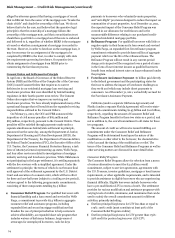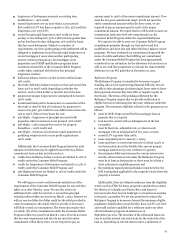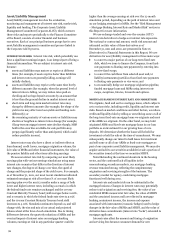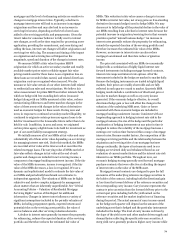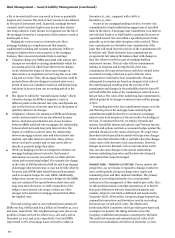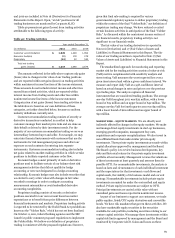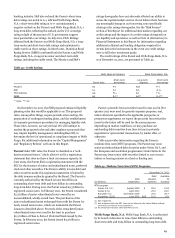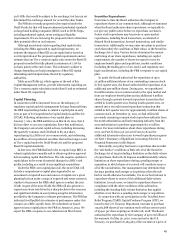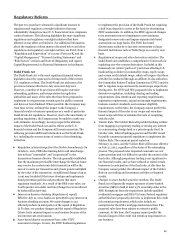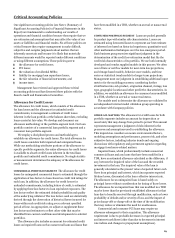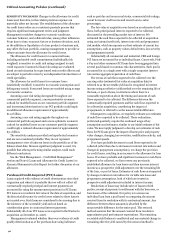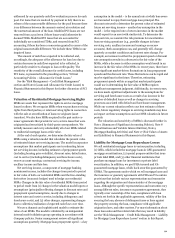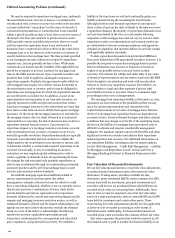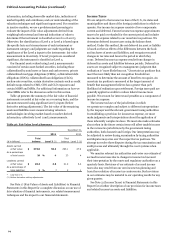Wells Fargo 2011 Annual Report Download - page 86
Download and view the complete annual report
Please find page 86 of the 2011 Wells Fargo annual report below. You can navigate through the pages in the report by either clicking on the pages listed below, or by using the keyword search tool below to find specific information within the annual report.
Risk Management – Asset/Liability Management (continued)
At December 31, 2011, Wells Fargo Bank, N.A. had available
$100 billion in short-term debt issuance authority and
$103.7 billion in long-term debt issuance authority.
Wells Fargo Canada Corporation In January 2012,
Wells Fargo Canada Corporation (WFCC, formerly known as
Wells Fargo Financial Canada Corporation), an indirect wholly
owned Canadian subsidiary of the Parent, qualified with the
Canadian provincial securities commissions a base shelf
prospectus for the distribution from time to time in Canada of up
to CAD$7.0 billion in medium-term notes. During 2011, WFCC
issued CAD$500 million in medium-term notes using its prior
base shelf prospectus. In February 2012, WFCC issued
CAD$1.5 billion in medium-term notes. All medium-term notes
issued by WFCC are unconditionally guaranteed by the Parent.
FEDERAL HOME LOAN BANK MEMBERSHIP
We are a member
of the Federal Home Loan Banks based in Dallas, Des Moines
and San Francisco (collectively, the FHLBs). Each member of
each of the FHLBs is required to maintain a minimum
investment in capital stock of the applicable FHLB. The board of
directors of each FHLB can increase the minimum investment
requirements in the event it has concluded that additional
capital is required to allow it to meet its own regulatory capital
requirements. Any increase in the minimum investment
requirements outside of specified ranges requires the approval of
the Federal Housing Finance Board. Because the extent of any
obligation to increase our investment in any of the FHLBs
depends entirely upon the occurrence of a future event, potential
future payments to the FHLBs are not determinable.
Capital Management
We have an active program for managing stockholders’ equity
and regulatory capital and maintain a comprehensive process for
assessing the Company’s overall capital adequacy. We generate
capital primarily through the retention of earnings net of
dividends. Our objective is to maintain capital at an amount
commensurate with our risk profile and risk tolerance
objectives, and to meet both regulatory and market expectations.
Our potential sources of stockholders’ equity include retained
earnings and issuances of common and preferred stock.
Retained earnings increased $12.5 billion from
December 31, 2010, predominantly from Wells Fargo net income
of $15.9 billion, less common and preferred stock dividends of
$3.4 billion. During 2011, we issued approximately 86 million
shares of common stock, substantially all of which related to
employee benefit plans. We also repurchased approximately
86 million shares of common stock at a net cost of $2.4 billion
during 2011.
Regulatory Capital Guidelines
The Company and each of our subsidiary banks are subject to
various regulatory capital adequacy requirements administered
by the FRB and the OCC. Risk-based capital (RBC) guidelines
establish a risk-adjusted ratio relating capital to different
categories of assets and off-balance sheet exposures. At
December 31, 2011, the Company and each of our subsidiary
banks were “well-capitalized” under applicable regulatory capital
adequacy guidelines. See Note 26 (Regulatory and Agency
Capital Requirements) to Financial Statements in this Report for
additional information.
Current regulatory RBC rules are based primarily on broad
credit-risk considerations and limited market-related risks, but
do not take into account other types of risk facing a financial
services company. Our capital adequacy assessment process
contemplates a wide range of risks that the Company is exposed
to and also takes into consideration our performance under a
variety of stressed economic conditions, as well as regulatory
expectations and guidance, rating agency viewpoints and the
view of capital markets participants.
In 2007, U.S. bank regulators approved a final rule adopting
international guidelines for determining regulatory capital
known as “Basel II.” Basel II incorporates three pillars that
address (a) capital adequacy, (b) supervisory review, which
relates to the computation of capital and internal assessment
processes, and (c) market discipline, through increased
disclosure requirements. We are well underway toward Basel II
implementation and currently anticipate entering the “parallel
run phase” of Basel II in 2012. During the “parallel run phase,”
banks must successfully complete at least a four quarter
evaluation period under supervision from regulatory agencies in
order to be compliant with the Basel II final rule. Our delayed
entry into the “parallel run phase” was approved by the FRB in
2010 as a result of our acquisition of Wachovia.
In December 2010, the Basel Committee on Bank
Supervision (BCBS) finalized a set of international guidelines for
determining regulatory capital known as “Basel III.” These
guidelines were developed in response to the financial crisis of
2008 and 2009 and address many of the weaknesses identified
in the banking sector as contributing to the crisis including
excessive leverage, inadequate and low quality capital and
insufficient liquidity buffers. The guidelines, among other
things, increase minimum capital requirements and when fully
phased in require bank holding companies to maintain a
minimum ratio of Tier 1 common equity to risk-weighted assets
of at least 7.0%. The U.S. regulatory bodies are reviewing the
final international standards and final U.S. rulemaking is
expected to be completed in 2012.
The BCBS also proposed additional Tier 1 common equity
surcharge requirements for global systemically important banks
(G-SIBs). The surcharge ranges from 1.0% to 3.5% depending on
the bank’s systemic importance to be determined under an
indicator-based approach that would consider five broad
categories: cross-jurisdictional activity, size, inter-
connectedness, substitutability/financial institution
infrastructure and complexity. These additional capital
requirements, which would be phased in beginning in
January 2016 and become fully effective on January 1, 2019,
would be in addition to the Basel III 7.0% Tier 1 common equity
requirement finalized in December 2010. The Financial Stability
Board has determined that the Company is one of the initial
84


